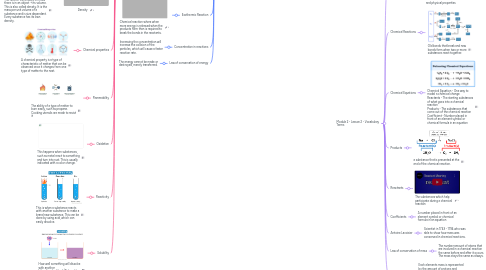
1. Temperature
2. Thermometer
3. Kelvin Scale
4. Potential Energy
5. Thermal Energy
6. Substances
7. Compound
8. Periodic Table of Elements
9. Science vocabs part 2
9.1. Molecules
9.1.1. A group of 2 or more atoms that form the smallest identifable unit which a pure substance can be divided.
9.2. Nonmetal gas
9.2.1. Can be individual atoms or diatomic molecules where there are 2 atoms of the same.
9.3. Nonmetal solid
9.3.1. A nonmetal solid is an individual atoms of the same type connected to form an extended structure.
9.4. Metal
9.4.1. Metal is a shiny and malleable so they can slide past eachother without even breaking.
9.5. Ionic compounds
9.5.1. Ionic compounds are bounds that form between atoms of oppopsite charges.
9.6. Covalent compounds
9.6.1. Covalent compounds share electrons together instead of giving them all away.
9.7. Polar covalent compounds
9.7.1. Some compounds have one side with a slight positive charge.
9.8. Nonpolar conalent Compounds
9.8.1. Nonpolar conalent compounds are neutral in terms of change difference and do not pull in one dierection or another
9.9. dissolving
9.9.1. become or cause to become incoporated into a liquid.
10. Science vocabulary terms september 25 2023
10.1. Qualitative Characteristics
10.1.1. A characteristic you can observe such as color, gender, marriage status.
10.2. Quantitative Characteristics
10.2.1. A characteristic you can measure such as mass.
10.3. Mass
10.3.1. Something that is dierectly related to the amount of atoms that make up multiple organisms. For example, How much “stuff” makes it up. This is often measured in kilograms (kg) or grams (g)
10.4. Weight
10.4.1. Weight is not exactly the same as mass but its a little simular. It is basically directly related to the mass of an object and is dependent on the gravitational force that is acting on it.
10.5. Volume
10.5.1. the amount of space a substance takes up is also size dependant. The larger something is, the more volume it will soon take up. Units for volume are cubic centimeters (cm3) liters (L) and milliliters (mL).
10.6. Density
10.6.1. The ratio of the amount of mass there is in an object + its volume. This is also called density. It is the mass per unit volume of a substance and is size dependant. Every substance has its own density.
10.7. Chemical properties
10.7.1. A chemical property is a type of characteristic of matter that can be observed once it changes from one type of matter to the next.
10.8. Flammability
10.8.1. The ability of a type of matter to burn easily, such as propane. Cooking utensils are made to resist it
10.9. Oxidation
10.9.1. This happens when substances, such as metal react to something and turn into rust. This is usually indicated with a color change.
10.10. Reactivity
10.10.1. This is when a substance reacts with another substance to make a brand new substance. This can be done by using acid, which can easily dissolve.
10.11. Solubility
10.11.1. How well something will dissolve with another Likes dissolve likes! (Polar with polar, nonpolar with nonpolar)
11. Module 2 lesson 3 Vocabulary terms.
11.1. Chemical Potential Energy
11.1.1. Energy that is released when atoms start forming bonds. The amount is dependant on the type of the bond.
11.2. Endothermic Reaction
11.2.1. Chemical Reactions where when more energy is required to break the bonds of the reactants than is released when products form.
11.3. Exothermic Reaction
11.3.1. Chemical reaction where when more energy is released when the products form than is required to break the bonds in the reactants.
11.4. Concentration in reactions
11.4.1. Increasing the concentration will increase the collision of the particles, which will cause a faster reaction rate.
11.5. Law of conservation of energy
11.5.1. The energy cannot be made or destroyed, merely transferred.
12. Module 2 - Lesson 2 - Vocabulary Terms
12.1. Chemical Changes
12.1.1. Matter can change into another substance with different chemical and physical properties
12.2. Chemical Reactions
12.2.1. Old bonds that break and new bonds form when two or more substances react together.
12.3. Chemical Equations
12.3.1. Chemical Equation - One way to model a chemical change Reactants - The starting substances of what goes into a chemical reaction Products - The substances that come out of the chemical reaction Coefficient - Number placed in front of an element symbol or chemical formula in an equation
12.4. Products
12.4.1. a substance that is presented at the end of the chemical reaction.
12.5. Reactants
12.5.1. The substances which help participate during a chemical reaction
12.6. Coefficients
12.6.1. A number placed in front of an element symbol or chemical formula in an equation
12.7. Antoine Lavoisier
12.7.1. Scientist in 1743 - 1794 who was able to show how mass was conserved in chemical reactions.
12.8. Law of conservation of mass
12.8.1. The number amount of atoms that are involved in a chemical reaction the same before and after it occurs. The mass stays the same as always.
12.9. Atomic Mass
12.9.1. Each elements mass is represented by the amount of protons and neutrons that make it up An element such as carbon has an atomic mass of 12, from 6 protons and 6 neutrons
